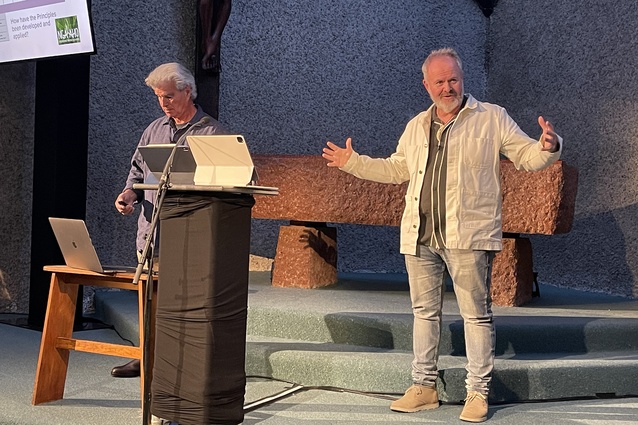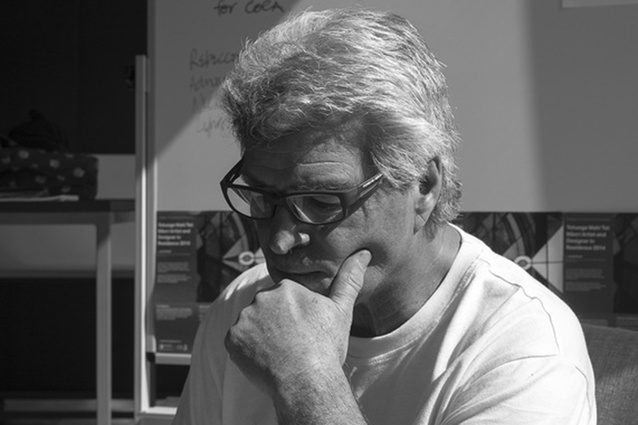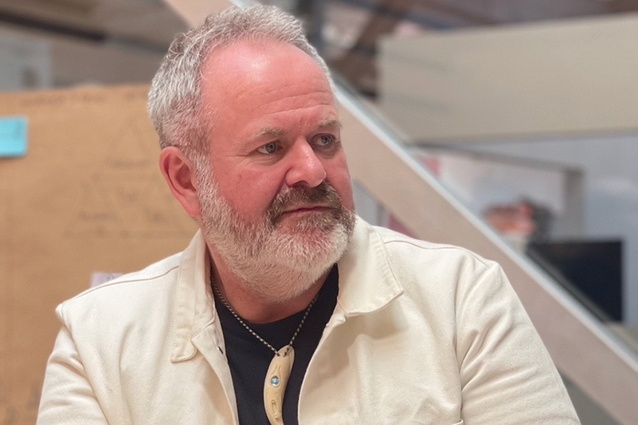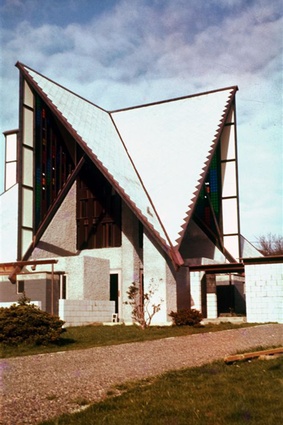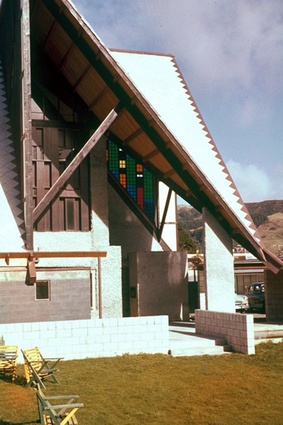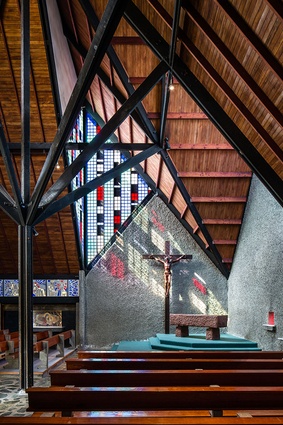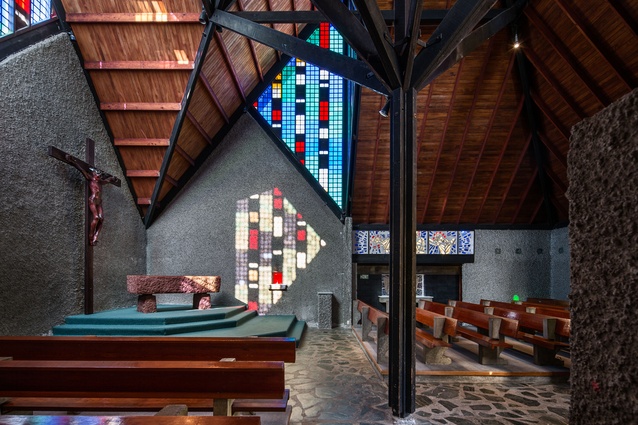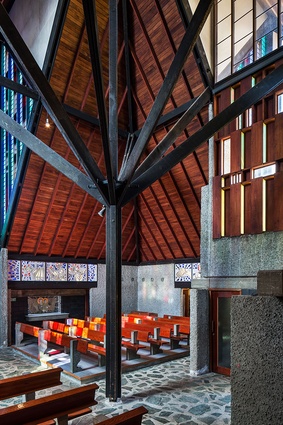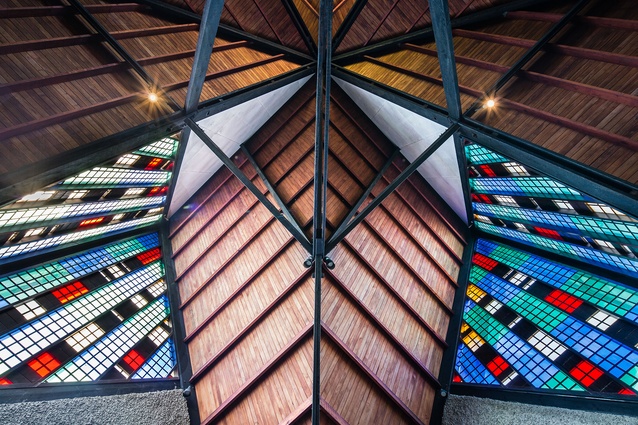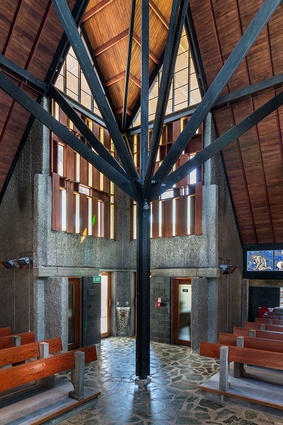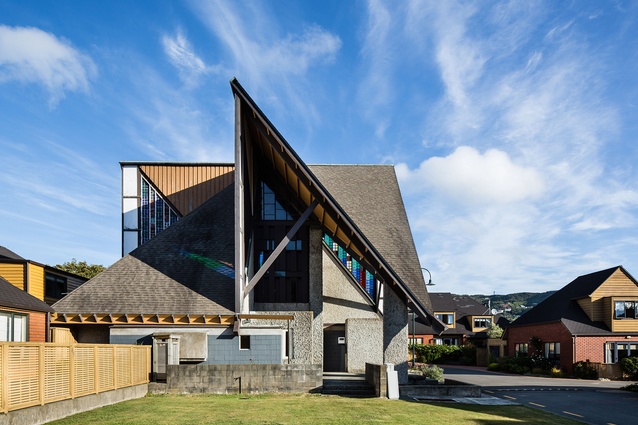Designing better futures for Aotearoa New Zealand: He tirohanga Māori, a Māori perspective
John Walsh attended the 2023 Futuna Lecture, delivered by Hawkes Bay-based designers Jacob Scott and Karl Wixon at Futuna Chapel in Karori, Wellington. Here’s his review.
In 2011, the charitable trust that had been established in 2003 to save John Scott’s Futuna Chapel at Karori, Wellington, initiated a lecture series to raise funds for the building’s conservation and promote awareness of its architectural significance. The chapel, which was commissioned by the Catholic religious order, the Society of Mary (the Marists) and completed in 1961, was sold, as a part of its wider site, to a developer in 2001; the Friends of Futuna Charitable Trust bought the chapel from him in 2006. Over the past dozen years, the Trust’s Futuna Lecture, annually presented in Wellington, Auckland, and Christchurch, has developed into a significant architectural occasion. The event’s organiser, Wellington architect Nick Bevin, has proved to be a master of the arts of persuasion, attracting strong sponsor support and luring celebrated international architects to Aotearoa.
The lecture series got off to a strong start. The first speaker was Australian Institute of Architects’ Gold Medallist Rick Leplastrier; the next, in 2012, was Rick Joy, the American architect peaking in popularity for his rammed-earth-and-steel buildings in the Arizona desert. In another life, Nick Bevin would have done well as a horse-racing tipster. His presenter picks in 2014 and 2015 were especially prescient: London-based Irish architect Níall McLaughlin, who went on to win the Royal Institute of British Architects’ Stirling Prize for best UK building (in 2022, for Magdalene College Library, Cambridge), and Chilean architect Alejandro Aravena, who was to receive the Pritzker Prize, international architecture’s leading personal award, in 2016, the same year he was curator of the Venice Architecture Biennale. Aware things were getting imbalanced, gender-wise, Bevin invited the Danish architect Lene Tranberg to deliver the Futuna Lecture in 2016 and the Australian-based, New Zealand multi-disciplinary practitioner Sarah Kenderdine – design academic/maritime archeologist/exhibition producer – to be the 2017 presenter. The 2019 Futuna lecturer was the Norwegian architect, writer, and critic Ingerid Helsing Almaass.
The Covid-19 pandemic forced a pause in the lecture series and then a pivot away from international speakers. In 2021 the Futuna Lecture was given by Wellington architect Hugh Tennent; in 2022, the presenter was Auckland architect Michael O’Sullivan. The local focus continued this year, when, for the first time, the lecture was a double-act, delivered by Hawkes Bay-based designers Jacob Scott and Karl Wixon.
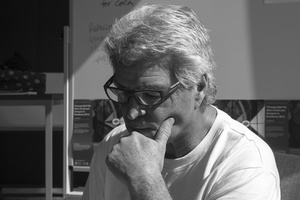
The choice of this year’s speakers was surely appropriate. Who better to give a talk named for the most famous building of the most acclaimed later-20th century Māori architect than John Scott’s son, Jacob (Ngāti Raukawa, Te Arawa, Ngāti Kahungunu, Te Ātiawa), and Jacob’s frequent design partner, Karl Wixon (Waitaha, Kāti Māmoe, Kāi Tahu, Ngāti Toa Rangatira, Moriori)? And where better to hear the talk than Futuna Chapel? (The lecture was also staged at St Andrew’s College Centennial Chapel, Christchurch and St Matthew-in-the-City, Auckland.)
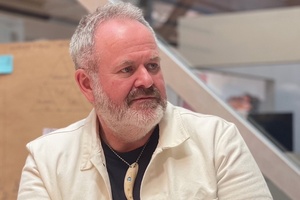
Scott and Wixon titled their talk “Designing better futures for Aotearoa New Zealand: He tirohanga Māori/A Māori perspective.” Bevin wasn’t to know when he sent his invite to this year’s speakers – although, given his aforementioned foresight, he may have had an inkling – that the topic would be so timely. The 2023 Futuna Lecture was given shortly after the publication of a big book (Rewi, by Jade Kake and Jeremy Hansen, Massey University Press), accompanied by an Auckland exhibition, about another significant Māori architect, Rewi Thompson. The lecture series occurred, also, in the immediate wake of an election campaign that featured dog-whistle messaging and some overt rabble-rousing about the place of tangata whenua in the nation’s polity and culture.
Another backdrop to the lecture series is the evolving Māori involvement in architectural projects, especially public or institutional projects of any scale. This development is reflected in the structures of architecture practices. Large firms, such as Jasmax and Warren and Mahoney, have established Māori design units, a move that is, at least in part, a supply-side response to client demand. It will be interesting to see how the pace of this progress is affected over the next few years, with a rightwing coalition government in office.
“He tirohanga Māori/A Māori perspective” on design: again, there can’t be many more fitting places to discuss this subject than Futuna Chapel. The lecture given by Scott and Wixon was not a primer in Māori architecture or design. Nor did it pore over one of the hardy perennials of the country’s architectural historiography: the ‘Māoriness’ of Futuna Chapel. Sitting in a Futuna pew, though, while listening to Jacob Scott, who was obviously deeply moved to be at the lectern in his father’s wonderful building, it was impossible not to ponder the topic. The design of Futuna Chapel has been variously interpreted over the years. Russell Walden, the Victoria University academic who in the 1980s set himself up as an expert on the building, saw it as a fusion of Māori and European architecture. Architect and writer David Mitchell didn’t go that far but discerned some Māori/European crossover. Historian and critic Bill McKay regards the chapel as ‘assimilationist’ rather than bicultural. Futuna Chapel’s cultural essence is probably a question without a definitive answer. However, I think we’ve reached the stage where Pākehā writers, like this reviewer, are best to bow to Wittgenstein’s adamantine logic: ‘Whereof one cannot speak, thereof one must be silent.’
There were, however, other things to think about as the lecture in Futuna Chapel proceeded. (That’s what happens when you hold a talk in a work of art.) Specifically, the contributions of John Scott’s collaborator, the sculptor Jim Allen: the Stations of the Cross; the light modulators above the entrance; the coloured Perspex windows; and the extraordinary mahogany crucifix. Futuna Chapel is no longer a sacred space but Allen’s figure of Christ on the cross is such a powerful, super-scaled presence that it makes the building’s deconsecration a moot point. The Marists have moved on, but is God still in the building? (For a discussion of decommissioned Futuna Chapel’s location on the sacred-profane scale see the late Anglican bishop Jim White’s article “A Grave Concern” in Architecture NZ, November-December, 2019.)
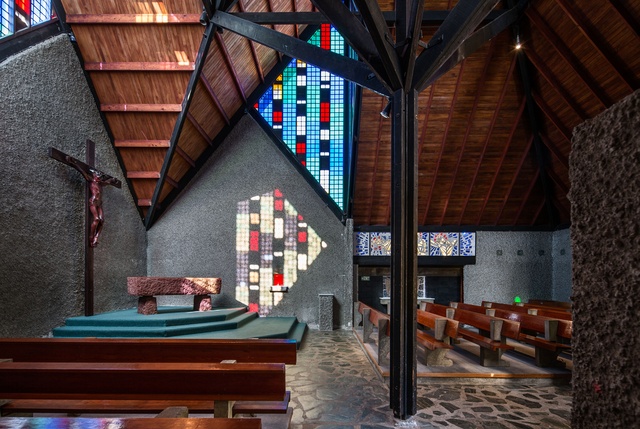
Near the start of the lecture Jacob Scott put down a marker for the ensuing discussion by citing an article his father had written almost 60 years ago. The piece is immediately notable for the fact of its existence: I’m not sure how much John Scott (1924–1992) wrote about his work, or architecture generally. (He did, though, leave an archive of 7,000 drawings that his whānau has gifted to the Alexander Turnbull Library.) And the source of the article is also striking: The New Zealand Herald. Accustomed as we’ve become to the Herald, and other New Zealand media, treating architecture as an adjunct of the real estate ‘industry’, it is surprising to come across an article, published on 23 September 1964, devoted to the relationship, as expressed in the country’s architecture, of Māori and settler design cultures. (Back issues of The New Zealand Herald are held at the Alexander Turnbull Library and Auckland Central Library.)
In his article, from all those years ago, John Scott lamented what he regarded as the devolution of Māori arts and crafts to ‘applied decoration.’ The decline began, Scott seems to say, in the later nineteenth century after an earlier period – when the balance of power between Māori and settlers was more equal – of interaction that portended ‘an indigenous New Zealand architecture.’ (This position could be characterised as ‘assimilationist’, if such a retrospective reckon is at all helpful.)
In his Herald article, Scott pressed the claims of architecture with an ex-cathedra certitude that equalled Frank Lloyd Wright’s pronouncement that ‘the mother art is architecture.’ Scott wrote that architecture is ‘a complete art, embracing aspects of all the arts in a common end in terms of man.’ In Māori tradition, that is, architecture and art are complementary and inter-dependent. (In his Futuna collaboration with Jim Allen, Scott certainly practised what he preached.) ‘Māori art… was consistent with a way of life and the material used,’ Scott wrote. Note the past tense; for Scott, writing in 1964, ‘the place of Māori art now has been obscured by sentiment and the tourist trade.’ Craft had become perverted as ‘curio’, and Māori making traditions had been co-opted in the cause of providing Pākehā New Zealand with some sense of national identity. In these circumstances, Scott wrote, the ‘copied motifs’ of Māori art are ‘unrelated to [architecture’s] purpose and intention.’
Scott did not end his 1964 article on a pessimistic note. He left open the prospect of a meaningful collaboration between artists ‘who understand the medium of Māori art and who recognise its importance’ and ‘sympathetic’ architects with compatible intentions. For all that, Scott’s piece was an indictment of both the relationship of Māori art and design with architecture and the contemporary condition of New Zealand architecture itself – ‘buildings are still pretentious; [architects] do not explore the special possibilities; people are machines.’
‘So, what has changed?’ Jacob Scott asked in the Futuna Lecture. ‘Not much,’ he said. But some things, perhaps. For example, Scott referred to his own contribution to the design of Te Ara Hihiko, the College of Creative Arts on Massey University’s Wellington campus. From the project’s early stages, Scott worked alongside Athfield Architects, designing carved interior and exterior panels for the building, which was completed in 2012. This was an opportunity to tell a story in a building, Scott said, a start-from-scratch exercise without the ‘need to koru.’ (In the decades around the turn of this century, the representation of an unfurling silver fern frond on a building or paved courtyard was a sure sign of a box being ticked in a lazy wave to indigeneity.)
John Scott’s 1964 article was an appeal for Māori art to be driven deeper into the country’s architecture projects. In their lecture, Jacob Scott and Karl Wixon were advocating for Māori design principles to be built into projects from the ground up. Scott and Wixon are prominent members of Ngā Aho, the Māori designers’ organisation, which was set up in 2006, and were closely involved in the formulation of the Te Aranga Māori Design principles. (The principles were named for a gathering at Te Aranga Marae near Hastings, not far from The Grange, the house at Haumoana where John Scott was raised, and which has been a Scott whānau home for over a century.) Wixon, too, has been closely involved with architectural projects which sought to realise Māori design principles or, to use Jacob Scott’s phrase, ‘tell a story.’ The broad scope of his work ranges from Te Ao Māhina, the Wellington Zoo Nocturnal House, on which he was design lead, to his contribution to the foundation of Otautahi Christchurch cultural consultancy the Matapopore Trust.
A decade and a half on from the development of the Te Aranga principles, Wixon in the Futuna Lecture said the time has come for ‘version 2.0.’ His call for a reboot is not surprising. Since the early 2000s, increasing attention, here as around the world, has been paid to the issue of decolonisation. This now means not so much the deaccessioning of imperial ‘possessions’ as the process of dealing with the residue of colonisation within former imperial powers and their settler offshoots. Government agencies, cultural institutions and professional bodies have all been urged to address the legacy of colonialism in their structures and practices. (This territory promises to be heavily contested over the next few years.)
The current swirl of ideas about decolonisation informed Wixon’s part of the Futuna Lecture. If the talk was a net, it would have captured a hefty conceptual catch. Many ideas were organically connected in the discussion of ‘Nature’s system logic’ and its alignment with the layers of Māori story telling. Wixon’s design philosophy, as expressed in his lecture, is holistic, as is his prescription for practice. He evoked the figure of the tohunga, not so much as priest but as expert, the repository of traditional design and making knowledge, the person who held the skeins of collective projects together. This sounds, superficially, like some Western architects of olden times, designers like Wright or Walter Gropius or Mies van der Rohe, both visionaries and masters of all the details. But, as Wixon later remarked, one key difference between modernism’s hero-architects and the tohunga, those broad-spectrum knowledge holders, is that the former imposed their architecture on society and communities, while the latter were directly responsible to, and for, the people among whom they lived.
It does seem that modernist architecture, which has well and truly been sent to history’s dogbox for the abandonment of its social democratic principles and the dystopian fulfilment of its utopian promise, is about to be further chastened for its collusion with colonisation. It’s true, the Bauhaus School ended up generating the producers of global capitalism’s colonising International Style. In 1964, John Scott was claiming, in his New Zealand Herald article, that as far as New Zealand’s deracinated architecture went, the “rot had set in.” But in its wilder Weimar days the Bauhaus was animated by a free-spirited determination to dismantle the barriers between art, craft, and architecture. John Scott might have approved of that endeavour, which was, perhaps, compatible with the characterisation of the indigenous design of Aotearoa he shared with readers of The Herald 60 years ago: ‘Combine any of the visual arts with architecture, where each complements the other and each depends on the other as a whole, that that is the tradition of Māori art.’
The Friends of Futuna Charitable Trust wishes to thank the following sponsors for their support of the Futuna Lecture Series: Dulux NZ, Metalcraft Roofing, Plytech, APL, The Warren Trust and the Auckland, Christchurch and Wellington branches of the NZIA.

